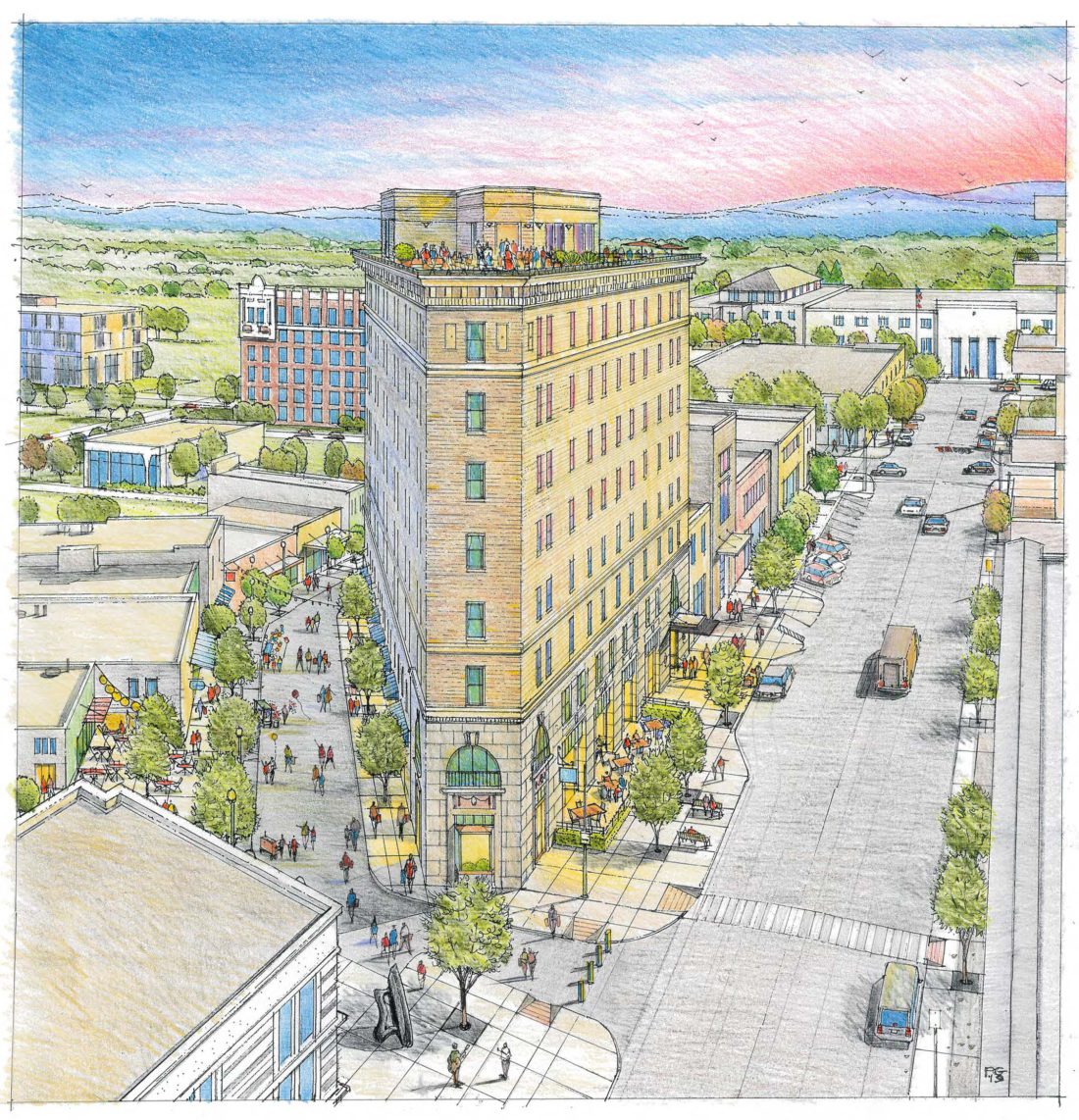Two years ago, many Asheville residents took sides in a debate over the future of one of the city’s most iconic buildings. Developer Philip Woollcott had proposed converting the Flatiron Building at 20 Battery Park Ave., an eight-floor neoclassical landmark built in 1927, into a 71-unit hotel with a restaurant and commercial space — displacing small retail shops on its street level and some 80 small-business tenants in the floors above.
Asheville City Council and scores of public commenters deliberated across two Council meetings about what should be done with the structure then-Council member Julie Mayfield had called “the soul of our city.” And in a 4-3 vote on June 26, 2019, Council approved the rezoning of the building to allow for hotel use. The Flatiron was sold to Woollcott in August 2019 for approximately $15 million; after pandemic-related financing and permitting delays, the developer says, construction is now underway.
The Flatiron debate marked a watershed moment in the city’s tourism-influenced development. Resistance to the plan, coming on the heels of similar previous battles regarding other hotels, catalyzed a 17-month moratorium on new Asheville hotel construction unanimously passed by Council in September 2019. In February, Council approved new rules that allow developers to build hotels of up to 115 rooms by right if they contribute community benefits such as public parking or funding for affordable housing and reparations.
The trajectory of the Flatiron now appears set, with a grand opening for the new hotel projected in early 2023. But what about the paths of the people who previously called the building their place of business? Mountain Xpress reached out to some of those directly affected by the Flatiron’s evolution to learn how the sale has impacted their lives since 2019.
Lost connections

Economic development consultant Francie Genz used to occupy an office at the Flatiron for $300 a month. When asked to relocate, she struggled to find comparable spaces. She considered coworking at The Collider in downtown Asheville, but concerns over COVID-19 transmission in the shared space ultimately led her to relocate to her home office.
Because her consulting business can operate remotely, Genz says, the move hasn’t disrupted her bottom line. But she says she’s felt the impact in other areas, particularly her ability to network with other local professionals.
“The bigger loss is to the Asheville economy. I’m less likely to do business with Asheville-based businesses and hire people,” she explains. “I hired an assistant recently, but she lives in Michigan. I’m more disconnected from Asheville in general.”
Genz, who organized a group of tenants to discuss the impacts of the proposed Flatiron sale back in 2019, believes many efforts to prevent the building’s conversion into a hotel focused on building preservation without recognizing how the local business community would be disrupted. “Is Asheville going to be a place where middle-class people live and work? Are we going to keep the central business district small-business friendly?” Genz asks. “That message got lost.”
Former tenant Adam Palmer, an information technology professional, shares Genz’s sentiments. “I can’t remember the last time I was downtown. [My colleagues and I] used to frequent businesses downtown, but we don’t do that anymore,” Palmer says.
When reviewing options to relocate from the Flatiron, Palmer says he was only able to find listings in Asheville with rental rates double what he had been paying. He tried coworking spaces but eventually decided to set up his new office at home.
“Coworking didn’t compare to the situation we had at the Flatiron, which was pretty much perfect in every way. There was a unique community of people there, and it’s a huge loss for the city not to have that around,” Palmer says.
Pivot points

Other former tenants say that, while they would have preferred to stay in the Flatiron, they were able to successfully transition to other spaces. Ed Draper, whose Draper Insurance Agency had occupied the building for 38 years, says he found a suitable — albeit smaller — location downtown after a challenging search.
Draper says he understands why Russell Thomas, the building’s majority owner and longtime manager, chose to sell and harbors no hard feelings about the move. Thomas had claimed that the building’s age led to mounting repair bills that couldn’t be covered by continued leasing as office space.
“It was old, and he had to spend a lot of money to upgrade it. When you throw 80 people out on the streets, that’s life. I’m 83 years old and I have never seen anything last forever. It lasted as long as it did, and I am happy for that,” says Draper.
The Rev. L.C. Ray worked out of the Flatiron for 20 years with his nonprofit One Youth at a Time, which offers mentoring and tutoring to at-risk local youths. He relocated that office to the WNC Baptist Fellowship Church, just a half mile away, where he serves as pastor.
“We had no problem finding a place and we had the option of moving to the church. That blessed us. It was one of those things,” Ray says.
And Chris Sparks, who ran print and web design business Sparking Design from the Flatiron for eight years, says he was able to locate a larger space with better parking in the River Arts District for less than his previous rent. He admits that finding the new spot was difficult, and he’s since moved into a home office. But he suggests that issues for Asheville’s small businesses can’t be tied to a single building’s closure.
“We don’t have enough affordable office space or housing. Pay for jobs is not enough. The housing market is through the roof, and Asheville just isn’t prosperous right now,” Sparks says. “We realize [the sale] impacted a lot of people, but at the same time, it was [Thomas’] building.”
Next chapter
When asked to look back on the experience of selling the building, Thomas says he was discouraged by how he was treated by the public and media. “It was all about a good news article,” he says. “I felt like some of the people wanted me out of downtown. They wanted to hurt me. They put up signs, did all kinds of stuff, rallied against us, when we were renting some things out that never went up on rent in 15 years.”
Thomas, the Flatiron’s building manager for 34 years, says he carries positive memories from his time overseeing the property but is happy to be done with it. He invested some of the proceeds from the sale into residential duplexes in Weaverville, which he currently manages alongside a farm north of Asheville.
While he recognizes the inconvenience of the sale to tenants, Thomas says, “All the people that had been there forever were very supportive. They didn’t want to speak out, but they wanted to do the right thing and take care of the Flatiron.”
Thomas adds that he does occasionally speak with some of those long-time tenants and that they are all “doing fine.” He says he hasn’t heard of tenants experiencing negative outcomes from dislocation.
But Thomas says the repercussions of the sale have lingered for him. “I am affected because of the way the general public treated me,” he explains. “Now I am a dirty guy because I worked for 16 hours a day for 34 years to come to fix leaks and water flows and everything else? I was tired of doing the same thing every day. I am glad to be out.”




“Thomas says the repercussions of the sale have lingered for him. ”
I bet the $15 million will linger for longer. Anyway, can’t pin the blame on him: people make decisions in their own interests. Yes, office rents at the Flatiron were affordable in part because the building was under-maintained. But there is still not enough office space for single-person businesses at any price, and that’s not simply market forces at work. There is inadequate supply.
(Compare and contrast with 101 Charlotte.)
It was still the dumbest and most significant hotel approval since the Aloft, and potentially has more repercussions. It most likely prevents Wall Street from being pedestrianized, when doing that should be a bare minimum for downtown. It added things already in high supply and took away from those in low supply. In hindsight we might wish that the city had bought it instead. At $15 million, its value was equal to… the TDA marketing budget. Perhaps the city should have bought it and very loudly requested the TDA to pay for the refurbishment.
In the past couple decades so many of us have moved further from downtown. I left the Shiloh area to move to Arden near Biltmore Park and I love it here. I do miss going downtown which I almost never do anymore. When I do I never see a single person I know. Back in the day I ALWAYS ran into friends and acquaintances, many local downtown business owners, that I knew. It’s so sad that Thomas has had to endure a backlash from the sale of the Flatiron. It was inevitable. As he commented, nothing goes on forever. Still, it’s a shame that downtown has become a rarified place for tourists only. When I do get downtown it’s just about impossible to park at any time of day. I’m all for change but I do miss downtown Asheville a lot. I guess when I feel safe enough I could rent a hotel room for a night or two to experience my favorite places again . . . if they are still there.
On those rare occasions I do go downtown I am quickly reminded of why I am so seldom there anymore. It’s for all of the reasons you mention….and then some.
I kind of agree that Thomas became the face of much broader structural problems about land use downtown; on the other hand, $15 million may not go on forever but it goes on a long way. City Council set as terrible a precedent by approving the hotel conversion as it did by approving the Aloft.
“When I do get downtown it’s just about impossible to park at any time of day.”
That’s just not true. It might be impossible to park for free within a minute’s walk of your destination, but “there’s no parking” stopped being a credible thing to say a few years ago. There’s a website telling you where you can park. Pay a couple of dollars out of what you’re saving in property taxes by living outside the city limits. And if you really want to park for free then you have the movie-set downtown at Biltmore Park.
https://www.avlpark.com/
Your ongoing Aloft commentary is pretty funny. For those who weren’t around in those days, prior to development, the lot was a trash strew, potholed parking lot somewhat fenced by broken down wire. Oh, and of course, there was the hot dog king. In today’s language it would be described as a s**t hole.
And now it’s a marooned cruise ship.
There’s an Aloft in Portland, OR that looks exactly the same except it’s on a big lot on the outskirts of the airport next to an Ikea. It makes sense in that location. The Aloft in Chapel Hill is next to a six-lane drag and has a red-brick exterior. That makes sense too.
It was the first big McKibbon project and set a precedent for every other downtown hotel project in that wave: given that the city approved that fugly out-of-place thing, it couldn’t reasonably object to anything slightly less fugly and out of place. It also set up a process whereby hoteliers made “concessions” and promises to the city that have not always been kept.
You should consider a job as a central planner somewhere. I can’t imagine anything funnier than our keystone kops kouncil passing judgement on hotel aethetics.
I’m not going to argue with you there. I wouldn’t want to be a central planner but I think that buildings should respect the space in which they’re built.
I also think Chris Day of Civil Design Concepts deserves a plaque so that people know he was responsible for some of the fugliest modern buildings downtown, and I think that City Council indulges his terrible designs far more than it should. But the Aloft was a cookie-cutter meant for a completely different kind of space. Trust me when I say that when you see the one in Portland you understand where that kind of hotel is meant to be. I didn’t hate it there: it looked nicer than every other airport hotel. It’s an airport hotel. It’s in its DNA.
But: P&Z has not been as terrible in recent years as it was during the initial hotel boom. I know that Laura Hudson got a lot of flak for her recent op-ed but she was right about the BB&T / Arras conversion being a terrible plastic overlay that will wear like a pair of cheap shoes, and I also think she’s basically right about 101 Charlotte.
Mr. Blissett doesn’t explain his objection to the Aloft Hotel, so it’s helpful for Indy499 to remind us of what was there previously.
To repeat: sure, the Hot Dog King property was an ugly empty space, and the owner allowed it to get that way until cashing out, but the Aloft was (and still is) a sprawling bleached lump that follows a design meant to sit on a big-box drag and is completely inappropriate for that space. Its approval opened the door for every other new darn downtown hotel, because none of them are as fugly or inappropriately situated as that one.
Here’s the Aloft at Cascade Station. it is essentially the same hotel, except it’s on a drag between Portland and the airport, and conveniently located near the Best Buy, the Petsmart and the Buffalo Wild Wings. That’s where Marriott typically situates Alofts. It would have fitted right in on Tunnel Road or south of Biltmore Village.
https://goo.gl/maps/tcpfW5vFR2g5PTXR9
Blissett. Your ignorance is very entertaining. Chris Day is a civil engineer. He doesn’t design buildings. He’s strictly water service, storm water and sewer design. Architects design buildings. Civil engineers design pipes underground. You and Marilyn Ball need to give Ol’ Chris a break.
I will admit that I may have been misinformed when local news outlets treat Chris Day as the lead on these projects because he’s the one who shows up to P&Z hearings, but perhaps that’s their fault more than mine. But I stand corrected: it’s really Peter Alberice who deserves the city’s scorn and the plaque of shame for so many absolutely fugly buildings.
Your objections to the Aloft on aesthetic grounds are well articulated, Mr. Blissett. Does the City of Asheville have any aesthetic-design standards in any of its codes that would address these issues? Is there any consensus on what types of architecture (Art Deco, French Renaissance, in the style of the Biltmore House, Victorian/Victorian Gothic, as in Montford, the English village style of Biltmore Village and the are around the Manor Inn, Modernist, as in the I.M Pei-designed Biltmore Company building in Pack Square and now the new art museum, are appropriate for any of Asheville’s business districts or residential neighborhoods? Does Asheville have anything equivalent to the Federal Fine Arts Commission which governs the aesthetics of Washington, DC? Should Asheville have such a commission?